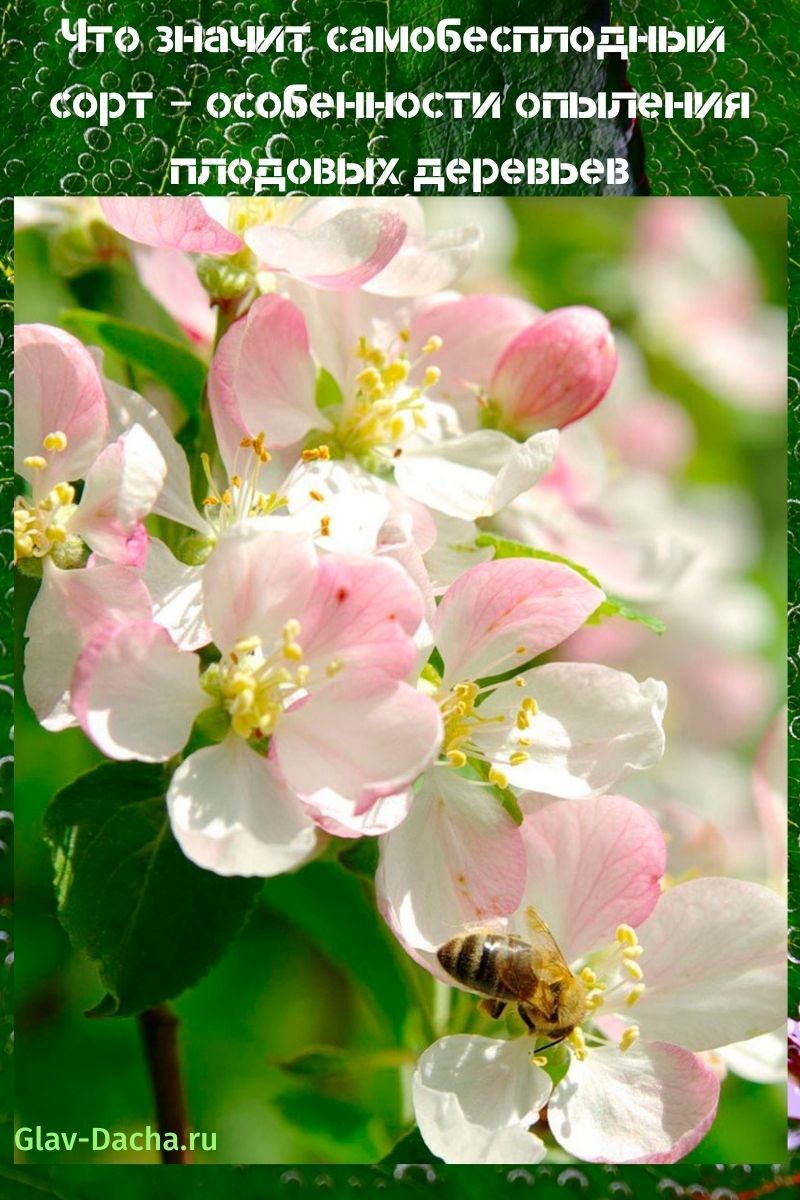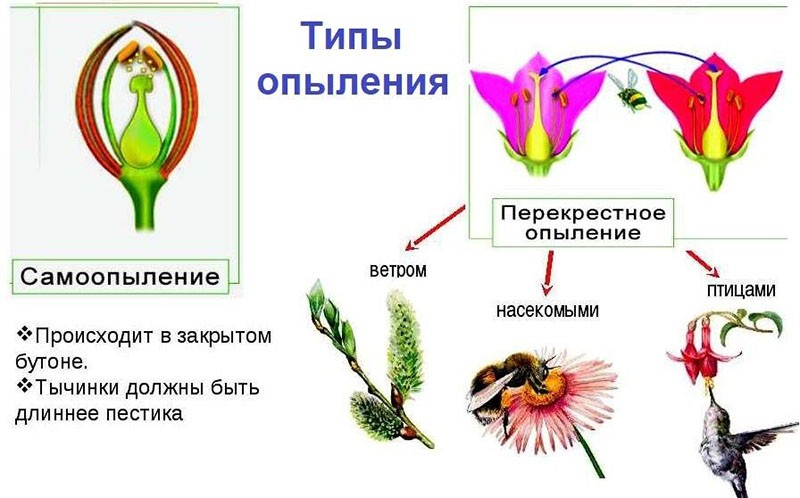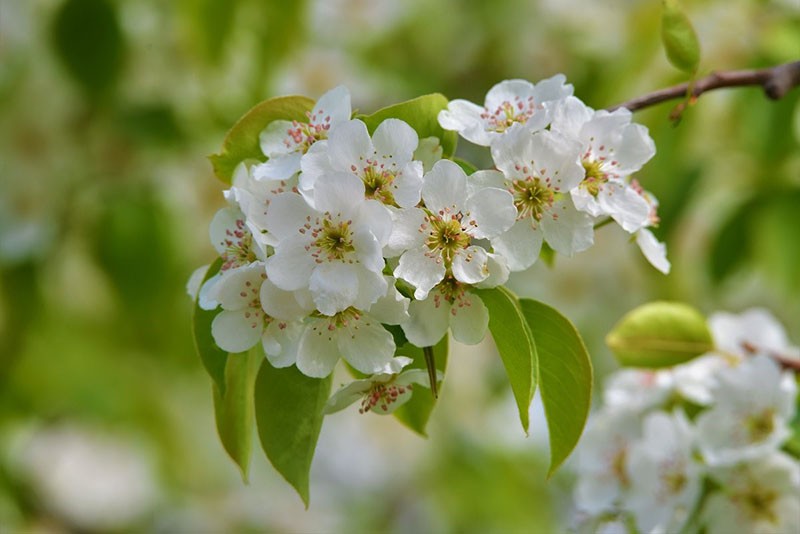What does a self-fertile variety mean - features of pollination of fruit trees
 Every gardener knows that a lush spring flowering of fruit trees is not a guarantee of a rich harvest. Indeed, the main factor affecting fruiting is considered to be high-quality pollination of plants. That is why when growing fruit and berry crops, it is necessary to take into account what a self-fertile variety means, which crops are capable of bearing fruit on their own, and which ones require pollinators.
Every gardener knows that a lush spring flowering of fruit trees is not a guarantee of a rich harvest. Indeed, the main factor affecting fruiting is considered to be high-quality pollination of plants. That is why when growing fruit and berry crops, it is necessary to take into account what a self-fertile variety means, which crops are capable of bearing fruit on their own, and which ones require pollinators.
Pollination methods

Male cells in the form of pollen contained within the stamens of flowers are carried to the ovules or pistils, which are female reproductive cells. After a while, ovaries form in their place, and then fruits are formed.
Pollination can be done in two ways - self-pollination and cross-pollination. The main difference between them is that a tree or shrub is fertilized on its own, that is, pollen from the stamen is transferred to the surface of the flower pistil on one tree or shrub. In the second case, pollinators are used, that is, pollen from nearby plants.
Cross-pollination types:
- hydrophilia - the transfer of pollen by water;
- anemophilia - particles of pollinating material are carried by the wind;
- zoophilia - animals interfere in the process of pollination;
- entomophilia - insect fertilization;
- artificial pollination - occurs with the participation of people.
In addition to various methods of pollination, all fruit and berry crops are divided into self-fertile, self-fertile, and also partially self-fertile varieties. Each of them has its own specific characteristics, they require different pollinators.
Self-fertile varieties
 Self-fertile varieties require only pollen from their own inflorescences for a successful pollination process, without the involvement of pollinators - nearby related plants or insects.
Self-fertile varieties require only pollen from their own inflorescences for a successful pollination process, without the involvement of pollinators - nearby related plants or insects.
Such varieties have a special arrangement of flowers, in which the stigma is located in one line with the anther. This allows for a lush flowering and bountiful harvest, even in adverse weather conditions.
Self-fertile varieties also have a significant drawback - they often have a small number of fruits. Therefore, experienced gardeners are advised to plant pollinating trees next to them.
Partially self-fertile varieties
A partially self-fertile variety is an "intermediate link" between self-fertile and self-fertile varieties of fruit and berry crops. Such trees are characterized by a reduced ability to fertilize.
If self-fertile plants are successfully fertilized from their own pollen in 45-55% of cases, then for partially self-fertile crops this figure does not exceed 20-25%.
What does self-fertile variety mean
 What self-fertile varieties mean are fruit and berry crops that have the ability to fertilize and bear fruit without outside help. Pollination of such plants has its own specific features.
What self-fertile varieties mean are fruit and berry crops that have the ability to fertilize and bear fruit without outside help. Pollination of such plants has its own specific features.
Professional gardeners know that this is a self-fertile tree - the so-called crops that require the help of bees or pollen from nearby pollinating plants.No more than 4-5% of flowers are capable of fertilization with their own pollen, therefore, in the absence of suitable pollinators nearby, the yield will be minimal.
When planting pollinating plants, it is necessary to take into account the compatibility of various fruit and berry crops, because some plants cannot be placed side by side.
In order not to be left without a crop, it is necessary to clarify the method of pollination at the time of purchase of a fruit seedling.
Artificial pollination
 Artificial pollination of fruit trees helps to increase the yield of fruit and berry crops under unfavorable conditions - a small number of bees or bad weather, which does not promote fruit set.
Artificial pollination of fruit trees helps to increase the yield of fruit and berry crops under unfavorable conditions - a small number of bees or bad weather, which does not promote fruit set.
You can try to solve the problem of the absence of insects with bait - spray the tree with a solution of 1-2 tablespoons of honey or sugar in 500 ml of water. But in cold and rainy weather, this method does not guarantee positive results. In this case, artificial pollination is applied. It is used for various fruit trees - pear, cherry, sweet cherry, apple.
Pollination of an apple tree by hand:
- The pollination procedure should be carried out in warm, sunny and calm weather.
- Use a brush, a piece of foam rubber or an eraser on a pencil to collect the pollen from the apple trees.
- It is best to collect it from several varieties of wood. When using a mixture of pollen, the likelihood of successful ovary formation is significantly increased.
- Collect the pollen in paper or plastic bags and seal tightly to avoid spilling the pollinating material.
- Using a small brush with soft villi, gently apply the collected pollen to the inflorescences of a self-fertile tree, being careful not to damage them.
Artificial pollination of all inflorescences takes a lot of time and effort. That is why experienced gardeners recommend pollinating only flowers that have blossomed no more than 2-3 days ago. From a bunch of inflorescences, it is best to choose those located in the center. This will ensure a good harvest of large fruits.
 The process of manual pollination of fruit trees can be accelerated by using an old toothbrush (preferably electric), a fan or hair dryer, the air flow of which is directed towards the inflorescences.
The process of manual pollination of fruit trees can be accelerated by using an old toothbrush (preferably electric), a fan or hair dryer, the air flow of which is directed towards the inflorescences.
Pollinators for cherries
 Effective pollination of sweet cherries is possible only if the pollinator tree is located at a distance of no more than 35-40 m.
Effective pollination of sweet cherries is possible only if the pollinator tree is located at a distance of no more than 35-40 m.
Pollinator table for cherries:
- Ethics - Yaroslavna, Donchanka;
- Little sister - Aelita, Ugolyok, Donchanka;
- Donetsk Beauty - Sister, Yaroslavna, Valery Chkalov;
- Yaroslavna - Early Melitopol, Tavrichanka, Drogana, Valery Chkalov, Aelita, Lesya, Annushka, Ethics;
- Aelita - Ugolyok, Donchanka;
- Ugolyok - Valeria, Ethics, Lesya, Annushka, Yaroslavna, Donchanka;
- Early Melitopol - Yaroslavna, Valery Chkalov;
- Valery Chkalov - Household, Early Melitopol;
- Drogana - Aelita, Sis, Donchanka.
 For the successful pollination of cherries, it is very important that no other fruit and berry crops grow between the pollinated trees - quince, pear, apple tree. In this case, the bees begin to transfer pollen from foreign pollinators, which will not lead to fertilization of the sweet cherry.
For the successful pollination of cherries, it is very important that no other fruit and berry crops grow between the pollinated trees - quince, pear, apple tree. In this case, the bees begin to transfer pollen from foreign pollinators, which will not lead to fertilization of the sweet cherry.
Pear pollinators
 Most pear varieties are self-fertile and do not require additional pollinators. Under unfavorable conditions, the gardener needs to take care of planting pollinating trees or manually manipulate.
Most pear varieties are self-fertile and do not require additional pollinators. Under unfavorable conditions, the gardener needs to take care of planting pollinating trees or manually manipulate.
Pollinator Chart for Pear:
- Klapp's favorite - Bere Bosk, Bere Beyk, Bon Louise;
- Curé - Bon Louise, Autumn and Winter Deccan;
- Williams - Autumn Deccan, Clapp's Favorite;
- Bere Bosc - Saint Germain, Williams, Clapp's Favorite;
- Autumn Bergamot - Tonkovotka, Bessemyanka.
The gardener needs to take into account that only summer varieties can act as pollinators for summer types of pears, and only winter varieties for winter ones.
For pear pollination, fruit crops of pome species are required - apple or quince.Pollination of pears by apple trees will bring a positive result if the trees have the same flowering period, it is annual, and pollen is generated in large quantities. Both trees should have approximately the same lifespan. There should be no mutual cross sterility between them.
Pollinators for apricot
 The way apricots are pollinated depends on the variety. Most of the varieties are self-fertile, capable of pollinating with their own pollen. But in the case of too early flowering or the absence of insects, the apricot requires manual pollination.
The way apricots are pollinated depends on the variety. Most of the varieties are self-fertile, capable of pollinating with their own pollen. But in the case of too early flowering or the absence of insects, the apricot requires manual pollination.
For artificial pollination of apricot, pollen collected from several varieties of trees is used. Due to this, the fruits will have a larger size and good taste. As the experience of professional gardeners has shown, manual pollination of apricot increases its yield by 45-55%.
The yield of fruit and berry crops depends on many factors, and one of the most important is their pollination. The correct approach to the formation of a garden, the choice of fruit seedlings and their planting, taking into account the ability and characteristics of pollination, will help to get a generous harvest of tasty and large fruits annually.